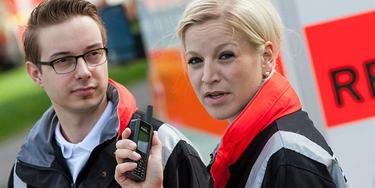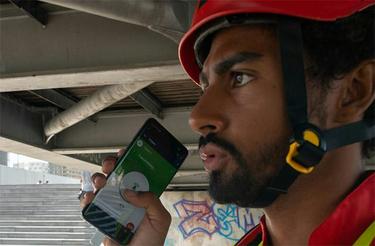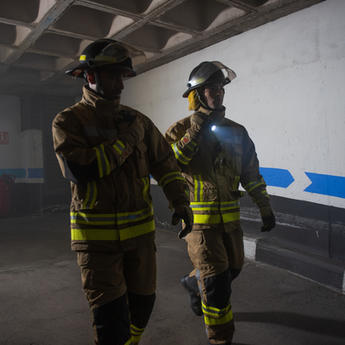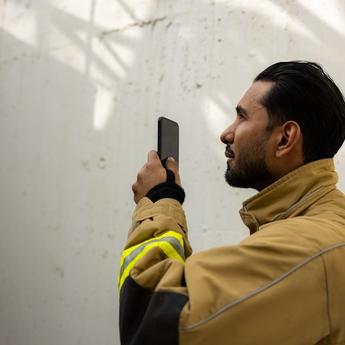Do you use TETRA communications and plan to bring smart devices or apps into professional use? If you do, take a look at this blog post. It answers the question “How does TETRA fit with smartphones?”
So, your organization has decided to adopt broadband and apps for professional use. How do traditional radios fit with smartphones and apps?
To get a thorough understanding of how TETRA and smartphones can work together, you will need to know the answers to three important questions:
1. What are the most valuable capabilities in TETRA?
What are the important strengths in today’s TETRA radio communications that users would hate to lose?
Availability: TETRA users can be sure that the communications will not let them down. Availability is built into the systems and that is one of the reasons why most TETRA operators have plans to keep their networks up and running until 2030 or even beyond.
Priorities: Priorities are closely related to the availability of communications. There are many features in the TETRA network and radios, designed to ensure that the most important communications will get through - even with heavy traffic. The special emergency call has the highest priority. Certain users will jump the queue if there is congestion in the network – they have higher priority. If necessary, lower-priority calls will be cleared to allow an important message to get through.
Priorities have been built into TETRA systems to meet the specific requirements of hierarchical organizations. They support the organizations’ operational models and the chain of command in an ideal way.
Security: Public safety and other professional user organizations have strict requirements for information security. That is why they need features such as authentication, mutual authentication, end-to-end encryption and Air Interface Encryption (AIE) security.
Coverage: Public safety professionals in particular may have to communicate anywhere. They need their communications network to have excellent, wide area coverage without black spots.
DMO: In case the TETRA network does not cover all operating areas perfectly, the radios can also communicate in Direct Mode, DMO. In other words, the user’s radio can connect directly to another radio (device-to-device), without the network. DMO is a lifeline for smoke divers. After all, it would be risky to rely on an indoor base station in the building on fire.

With these capabilities, TETRA is the reliable, efficient technology for voice communications in mission-critical operations. It also supports handy short text messages and status messages that are the basis for many authority operations. Voice and short data is exactly what TETRA was designed to deliver, and these needs are not going to disappear.
Public safety and other professionals will want to take advantage of their TETRA voice and short data communications for a long time. But they need broadband as well, to gain new benefits that rich data, video, and multimedia can deliver.
The smart solution is to use both TETRA and broadband. When the two technologies work seamlessly in parallel, they will deliver the best of both worlds: the strengths of TETRA as well as professional broadband data and apps. This way to evolve the communications to broadband is called the hybrid model.
Handpicked related content
How should you go about adopting broadband capabilities? How can you make sure that your TETRA to 4G/5G migration project is a success? This blog post has the answers: “TETRA to 4G/5G broadband migration - 14 ways to ensure success”.
2. What can a hybrid model bring to users?
In the hybrid model, users can continue with the communication services they are accustomed to. This their key requirement because those services meet their operational needs. In fact, the familiar communication services are the enabler for their current operational models.
The hybrid model will bring added value as well. For example:
Seamless communications between technologies. When the networks and devices are interoperable, people can communicate and cooperate together easily regardless of the technology they use.

A hybrid solution with built-in interoperability makes it possible for radio users and their smartphone-carrying colleagues to communicate seamlessly. This allows situations to be managed effectively. Examples include contacting a medical expert to provide a rapid diagnosis or a city official to warn citizens about a dangerous situation.
Better availability of communication services. Because there are two networks in use in parallel, there is a choice. For example, a hybrid device can choose to use the best available service – broadband, Wi-Fi or TETRA.
Handpicked related content
For example, the modern hybrid Tactilon Dabat device, equipped with the Agnet app, can roam between TETRA and broadband, allowing group communication to continue even when the bearer changes. This is called hybrid roaming. The ability to use a variety of bearers ensures users can communicate effectively in any environment with access to the network.
New capabilities. When TETRA communications are available, your organization will not have to replicate the services that already exist and work well. You will save time, effort, and money, and can use them to plan and build new and helpful options for user organizations – things that can only work on top of the new technology. User organizations will welcome new capabilities that serve an unmet need and offer them extra benefits.
Examples of new capabilities include the following:
Enhanced situational awareness. Applications using information from both networks can deliver a more complete picture of a situation. For example, video footage from drones, video from CCTV cameras, social media feed analysis and data in a variety of databases can be used to complement the information that people on site provide in their communications. This makes it easier for those in command to make the right decisions. Field users will be better aware of possible risks as well.

Those in command can also anticipate and prepare for what may happen next. For example, a wearable sensor can monitor a firefighter’s vital signs and exposure to carbon monoxide. When the exposure reaches a certain level, an alert can be triggered. The field commander can react in time and avoid a man-down situation.
Professional apps. Giving people in the field access to critical information in databases or being able to validate a passport using either a radio or a smartphone are examples of professional applications that can help public safety organizations fulfil their obligations every day. A hybrid network’s ability to handle multimedia and other large data also enables a wider variety of apps to be used. Organizations can use ready-made or tailored apps, depending on their needs.
New data services. Traditional radio networks such as Tetrapol and TETRA offer data services, but a hybrid network can offer completely new types of apps based on broadband data: real-time multimedia information with mission-critical priority and security, for example.

Visual information for better decision-making. A broadband connection lets users share multimedia with colleagues or dispatchers. Smartphone users everywhere have learned to use photos and videos taken on their phones for all kinds of purposes, from pictures and video for evidence or for making video calls with colleagues. This will also improve the overall situational awareness and help decision making, especially in critical operations.
Multimedia is increasingly used with automatic video analytics to detect and identify people through facial recognition and to identify vehicles by their type, color or registration plate.
Cameras have already opened great new possibilities for public safety professionals, and in a hybrid environment, storing and sharing photos and videos can be controlled by the user or performed remotely or even automatically. The user’s own situational awareness, safety and efficiency can be brought to a completely new level.
Video, online sharing or evidence for reporting. A video can be a personnel safety issue – for example when the dispatcher or field commander, with help of artificial intelligence, can observe a situation via a live feed from a video camera and send back up when needed.
Videos can be analyzed automatically and, when necessary, share the essential aspects of a current situation to all teams involved in the incident, with the same video used as evidence in reporting.
Handpicked related content ---
For an even more thorough list of benefits you can gain by adopting a hybrid solution, download eBook "50 powerful reasons you will want to adopt hybrid solutions".
3. How will TETRA and smartphones work together in a hybrid environment?
Those who use the additional broadband services in the hybrid environment will of course need a broadband capable device. TETRA and broadband users have the following options:
1. Carrying two separate devices – a TETRA radio and a smartphone.
2. Carrying two connected devices – a remote speaker microphone (RSM) connected with TETRA radio and a smartphone. The RSM will let the user to operate both devices.
3. Carrying two connected devices – a smartphone inside a special cover or sleeve connected to a TETRA radio. The cover or sleeve can include a loudspeaker and easy-to-use buttons, and it lets the user operate both devices.
4. Carrying one device – a hybrid, dual mode device that is a TETRA radio and smartphone in one, such as Tactilon Dabat from Airbus.

In addition to being handy to use, a single, hybrid TETRA+LTE device such as Tactilon Dabat can offer several practical benefits.
- Managing a fleet of devices is easier when users have one, not two separate devices. For example, a single device management software suite can be enough for complete fleet management.
- Choose the hybrid device wisely and it will be able to work in TETRA network mode (TMO), in Direct Mode (DMO), in LTE, and in Wi-Fi. That’s four modes in a single device.
- A well-designed app such as Agnet, for example, can choose which data bearer – TETRA, broadband, or Wi-Fi - is best for each service and can automatically roam between the networks according to their availability. This is called hybrid roaming.
- The device can feature dedicated, even tailor-made professional apps.
- Still and video camera integrated, so no need for a separate camera
- Battery and power management is more straightforward in a single device. The battery is changeable, so a spare battery can be changed even in the field.
- Accessories, chargers and charging options are needed only for one device, not two.
What’s more, a single, hybrid dual-mode device can be far less expensive than adopting two or more separate devices per user.
How to achieve seamless communications between TETRA radios and smartphones
A hybrid solution with built-in interoperability makes it possible for radio users and their smartphone-carrying colleagues to communicate seamlessly.

One enabler for seamless communications between radios and smartphones is Agnet, which lets smartphone users communicate in TETRA talk groups.
Agnet puts TETRA in your smartphone, so to speak. Your device becomes like a TETRA smartphone and lets you talk or exchange messages with people who carry a TETRA radio and also with the control room. You will also benefit from other things that are familiar from TETRA: the same TETRA groups, emergency calls, and location tracking, for example. All this with mission critical level of quality and security.
In short, users can continue with communication functions and features that are familiar from TETRA - even when they use smart devices.

Agnet is fully integrated into the Airbus TETRA system and broadband services.
Handpicked related content
The nationwide TETRA authority network VIRVE in Finland is on the migration path to broadband. Learn how they are planning to proceed.
When you adopt a hybrid model with seamless interoperability, your operations can continue without any breaks or service level deviations. Teams can communicate easily no matter which technology each team member uses, and security is not compromised. Start your migration to the hybrid world with careful planning and you can realize the ideal scenario where TETRA and broadband truly complement each other.






